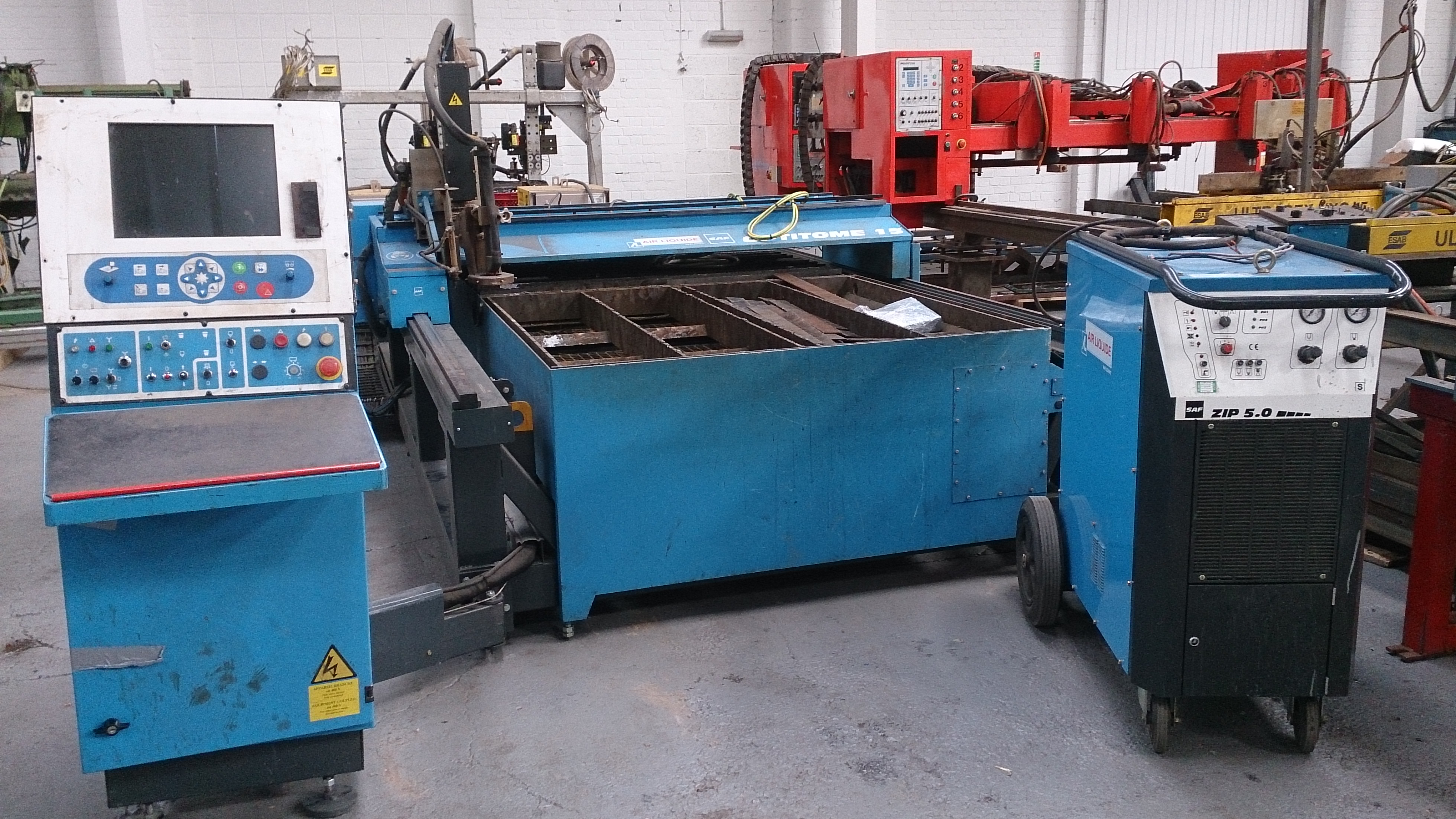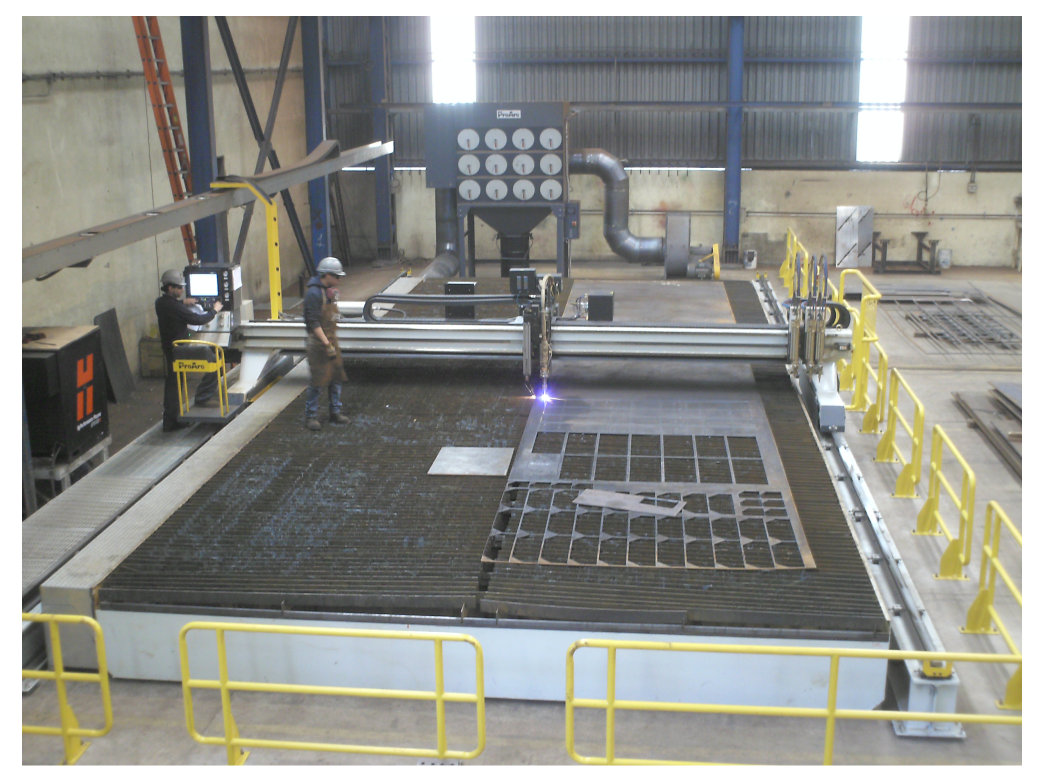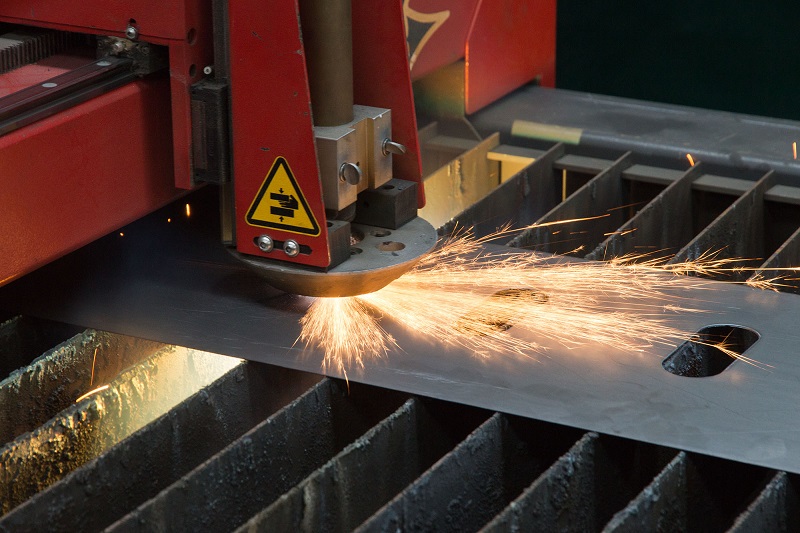Choosing a CNC Plasma Cutting Machine…
You have been given the go-ahead to buy a CNC plasma cutting system for the workshop. Maybe you have been out-sourcing your profile cutting but now it’s time to bring it in-house? Whatever it is, there are many factors to consider before buying or renting a cutting machine.
Our Experienced Team can offer objective advice about cnc cutting machinery, to buy, sell or hire. Over the years we have supplied all makes and models worldwide.
So which cutting machine is the best?
Selling such a wide variety of plasma cutting machines, we are often asked “which is the best?” and before we can answer that question, we always need to know what the machine is intended to be used for.
Machines are available with power levels from 30A for thin material and light duty work, all the way up to 800 amps for industrial fabrication use. Material thickness capability ranges from 6mm through to 160mm on mild steel, stainless steel and aluminium.
Before you make a decision, it is worth considering possible applications the machine will be required for. Productivity and accuracy requirements, and also cost/budget available for the initial purchase and operation costs going forward.
It is common practise now to operate the machine using a standard pc or laptop, with low cost drives and electronics available to make entry level CNC plasma tables available to a wide market.
Sizes starting from 2ft x 2ft up to 5ft x 10ft, most entry level requirements are covered. What’s more – with prices starting around £4000.00, these purchases can often be bought online like your grocery shopping and paid by flexible online payments with companies like Klarna.
The above have made investing in a plasma cutting table for the likes of hobbyist and small fabrication shops achievable, and although they don’t perform to industrial standard, they are ideal for occasional use and to be in control of your own cutting requirements.
The point of this article then is to help clarify the differences in performance, cut quality, and long term up time and reliability that will be necessary in the purchase and ownership of one of these machines.
However, just as a one man fabrication shop is not going to need an industrial machine at £100k, it is reasonable to assume that an entry level CNC plasma cutter is not going to be suitable for someone like a shipyard. So again differences in machine performance, reliability and cut quality are going to be important considerations for the industrial fabrication machine buyer.

Components to consider
All CNC plasma cutting machines, from the budget, entry level machine to the heavy duty workhorse must have the following components in one form or another.
CNC control
This is where the magic happens! The CNC unit is the brains and entire control over the whole machine. Programming converts drawings to electrical signals that control the cutting speed and direction, as well as signalling the plasma power source, height control and other components what to do and when!
Industrial CNC plasma cutting tables have a very sophisticated and robust CNC control unit. Featuring a variety of inputs and outputs controlling all aspects of the machine, from the drive motors to the plasma power source, height control and any other additional tooling fitted, as well as using internal motion and machine control software. It is controlled by both the machine operator and the CAM software, controlling all functionality and providing a truly automated and clever piece of kit!
However the costs involved with this type of control unit cannot be justified for a user that requires an entry level machine, and why not their requirements are completely different!
Most low cost machines are operated from a personal computer or laptop as opposed to a sophisticated control unit. Where the use of a computer would not be sufficient in a production and dirty workshop environment, this is not a problem for most small shops. They are usually equipped with an inverter type, air plasma cutting system that has “blowback” torch starting technology (this produces lower level of electrical interference and works well with computers) and have the ability to run motion, as well as limited input and output requirements.
This helps to keep the cost as competitive as possible and are designed with the hobbyist and prototype shop in mind, some are also suitable for smaller fab shops with low production demands.
An important consideration for any CNC control, whether that be a smaller or more industrial machine, is ease of use. If it is too complicated or not been designed with plasma cutting in mind specifically (some units feature software that are adapted from other CNC machining processes like milling and routing) then this will make the job much more awkward and can be costly if mistakes are made. Choosing a unit that is easy to learn and use on a day to day basis is one of the best choices you can make for the productivity of the machine and your own sanity!
Mechanical components
These are the moving parts that every CNC plasma cutting table must have and include the gantry (X and Y axis), torch carriage or cross axis, along with Z axis (up and down) that controls the torch to produce the required parts.
Understandably, these parts will differ from machine to machine so consideration is needed as to the production time of the machines and stress it will be under, think heavy duty and you will get a precise, overbuilt system that will ultimately cost you. However this will be of utmost importance to machines that will be working under continuous shifts, day in day out.
The same logic applies to entry level, light duty machines – mechanical components will reflect this and should be expected to be small, lightweight and low cost. Typically saving on areas including driver motors, gearing and electronics, allowing the system to perform it’s task with reasonable accuracy and reliability.
Stepper motors are used in the majority of entry level plasma cutting tables, being much simpler and lower cost, whereas industrial machines use servo drives and motors. Both have the ability to move the carriageway with good precision, however modern servo drive systems have a broader range of speed capacity, larger torque capability (improving the performance across a wider cut thickness and speed range). Servo motors and drives can also be more intuitive for machine operators, using encoder feedback to the CNC. This reduces the chance of lost positioning should an issue occur like a power failure or collision.
Fume Control System
All plasma cutting tables produce harmful fumes and smoke. It is of utmost importance to consider which fume extraction method would be suitable, however the machine you are considering may already have this covered. The most common option for entry level CNC plasma cutters is a water table. The design is a lot less complicated and ongoing costs are little, however if the machine ever becomes redundant, the water from the cutting bed needs disposing of correctly and in accordance with regulations.
The best and most efficient option for production machines is downdraft fume extraction tables with large capacity filter units. The fume extraction filter extracts fume and dust via ductwork built into the zonal cutting table. This is the safest and most ecological way of disposing of dust and fumes, however there can be ongoing costs such as replacing unit filters.

Height control
Technology varies when it comes to height control systems, as requirements differ across machine type. It allows for automatic control of the 3 necessary modes of height and provides excellent consumable life and cut quality, it should be fitted to all machines.
It is critical for the pierce height to be correct to help prolong the life and quality of the tip/nozzle in the cutting torch. One initial pierce being too close can result in loss of edge quality, cut edge angularity and can also affect dross. If the pierce height is set correctly, the height control will sense the surface of the material and retract to the correct pierce height.
Once the pierce height has been located, the torch will then descend to the correct cut height. This will often happen once the pierce delay timer has timed-out, to allow for a full pierce (most reputable height control systems have this function). Setting the correct cut height is critical to avoid incidents such as plate collisions when too low, or increased kerf and edge angularity, as well as dross and warpage when too high.
The arc voltage setting is the final piece of the jigsaw, this controls the ongoing torch to work piece distance, via arc voltage feedback and is initiated when the X and Y axis begin to move.
Industry standard height controls will have all of the above features, allowing the machine to go about it’s business while you walk away and continue with other tasks! Programme and nest hundreds of parts at a time – it is what they were built for!
The only instance where height control is not required, is if you are only cutting one part at a time and can be present during the operation. All of the above mentioned operations would need to be run manually and after each stage has been completed by the machine. Entry level machines can get away without height control, however industrial grade machines are not available without it – it’s what makes these machines truly automated and value for their money!
CAD and CAM software:
The cherry on the cake of all of these CNC plasma cutting table components is the software – CAD (computer assisted drawing/drafting) allows you to digitally draw the exact parts required to be cut, which is then inputted to the CAM (computer assisted machining/manufacturing) software.
The CAM software uses “post processing” to apply the necessary tolerances required for cutting the part; including kerf width, adding lead-ins and lead-outs to ensure the piercing process has as little effect on the finished piece as possible. This CAM file is then entered into the CNC control where it is converted into signals to control the entire process.
Some entry level cutting tables include combined CAD/CAM software which makes the transfer from drawing to cutting quick and easy. It also allows smaller shops to be able to draw and cut parts on the shop floor, while they are at the machine.
For more industrial and sophisticated requirements, there are CAM software packages that allows for much more functionality than the standard “post processing” as mentioned above. Often referred to as nesting software, this not only post processes CAD drawings, but also allows for accurate positioning of multiple CAD files in differing quantities, to most effectively utilise the plate of material to be cut.
As well as efficiently rotating and positioning parts, there is also a business aspect to the software, reporting on costing, waste, utilisation and more. Some software is so intuitive, it can set virtually every cutting parameter, from arc current and voltage, to cut speeds, cut heights and gas preflow! Minimising the room for human error, increasing productivity and reducing waste material.
How to choose!
In summary, there are a lot of things to consider when choosing to invest in a CNC plasma cutting table.
Look at your current needs in terms of part thickness, plate sizes, accuracy and productivity requirements, then re-consider these outcomes a few years down the line. You don’t want to choose an entry level machine now that has zero capability if you are looking at growing that area of the business. Budget will also be a consideration, you want to get the best value you can and a machine that will pay for itself after a short while!
Take a look at the variety of new, used and refurbished Plasma cutting systems, plasma profile cutters and CNC plate cutters in stock.

